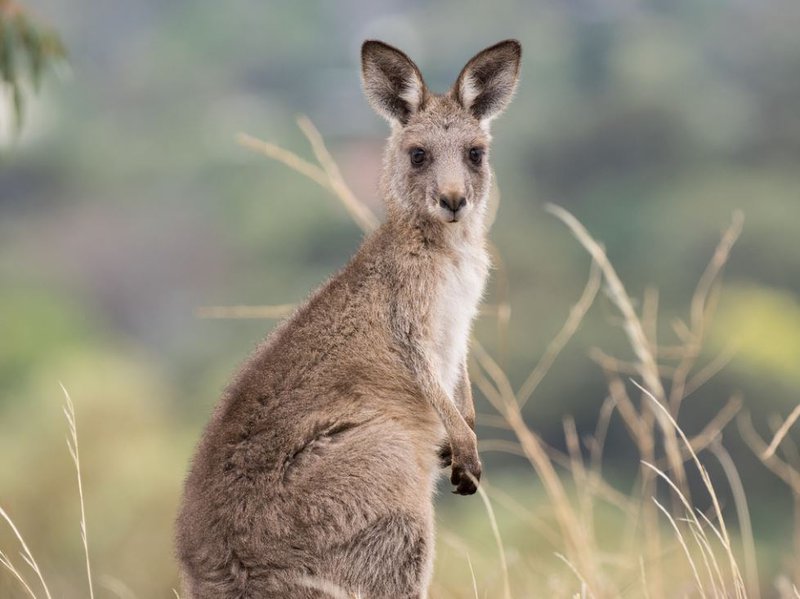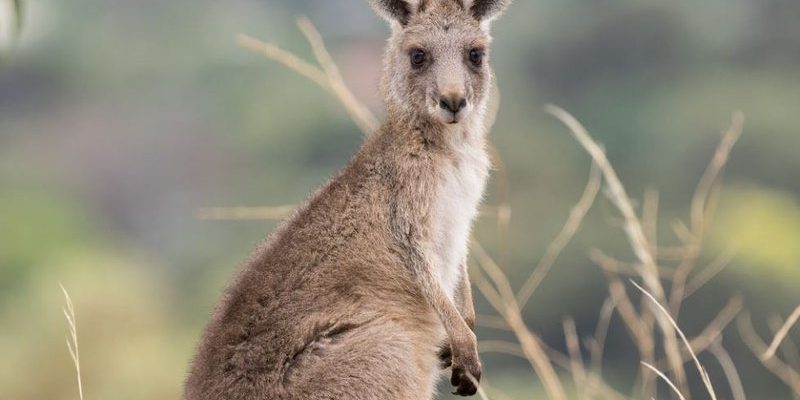
These kangaroos are more than just cute faces hopping around. They’re an integral part of the Australian ecosystem. You might be wondering how exactly they fit into this great puzzle of life. Well, let’s break it down together, and by the end, you’ll see why these kangaroos are so important.
Understanding the Eastern Grey Kangaroo
The Eastern Grey Kangaroo (Macropus giganteus) is one of the most common kangaroo species in Australia. Standing tall, they can reach heights of up to 8 feet when fully stretched out. Their grey fur helps blend into the Australian bush, providing both camouflage and warmth. Think of them as the ultimate outdoor survivors, perfectly adapted to their environment.
These kangaroos typically live in mobs, which is a fancy way of saying they hang out in groups. This social structure is crucial for their survival. Mobs work together to watch for predators, ensure there’s enough food, and care for the young. Honestly, it’s like a community potluck where everyone helps out. And speaking of food, they’re herbivores, munching on grass, leaves, and fruits. Their diet not only sustains them but also shapes the environment around them.
Impact on Vegetation
Eastern Grey Kangaroos have a significant impact on vegetation in their habitats. By grazing on grass and other plants, they help maintain healthy ecosystems. You might think of them as nature’s lawnmowers. When they eat, they encourage fresh growth and even help with seed dispersal.
Our furry friends nibble on various plant species, which prevents any single type from taking over. This grazing action promotes biodiversity. When different plants thrive together, it creates a more resilient environment. Healthy vegetation also provides habitat for countless other species, from insects to birds, making the ecosystem richer and more varied.
Moreover, their waste contributes to the soil’s health. When kangaroos poop, they’re not just leaving behind something unsightly; they’re spreading nutrients that enrich the earth. So, while they might seem like simple grazers, their eating habits really do have a ripple effect throughout their ecosystem.
Role in the Food Chain
In the grand scheme of things, Eastern Grey Kangaroos play a key role in the food chain. They’re herbivores, which means they sit pretty firmly at the bottom. But when you think about it, they’re also a vital food source for predators like dingoes and wedge-tailed eagles. It’s like a game of tag where everyone has a role to play.
When kangaroos thrive, higher predators, like those eagles, have plenty to eat. However, if the kangaroo population drops, it could lead to food shortages for these predators. This balance is crucial. It’s the circle of life, where each participant plays a part in maintaining the health of the ecosystem.
Furthermore, as kangaroos graze, they also create paths and clearings that can benefit other species. Smaller animals might find these open areas safer, allowing them to thrive as well. In this way, the Eastern Grey Kangaroo doesn’t just exist in its environment; it actively shapes it.
Contribution to Soil Health
The Eastern Grey Kangaroo’s impact goes even deeper—literally! Their grazing habits and nutrient-rich droppings significantly contribute to soil health. When kangaroos munch on grass, they help control its growth, which in turn promotes root development. Strong root systems stabilize the soil and prevent erosion, meaning less dirt gets washed away during rainstorms.
Plus, their droppings are a goldmine for soil microbes. As these nutrients break down, they create a rich compost that feeds the earth. Think of it as a natural fertilizer, essential for many plants to flourish. Healthy soil means healthy vegetation, which can sustain a diverse range of wildlife.
In many ways, these kangaroos are nature’s gardeners, shaping the landscape and nurturing the earth. Without them, you’d see a significant decline in soil quality, which would have knock-on effects throughout the ecosystem—from plant growth to insect populations.
Impact of Their Behavior on Other Species
The way Eastern Grey Kangaroos behave also influences other species in their environment. Their grazing not only affects plant life but also creates habitats for smaller creatures. For example, some birds thrive in areas where kangaroos have grazed because they find easier access to seeds and insects in the open spaces.
These kangaroos often create a sense of order in their ecosystems. When they move through their territory, they leave trails that can be used by other animals. Imagine taking a shortcut through a park; it’s easier to navigate when someone else has paved the way. This behavioral pattern encourages other species to follow, leading to a more interconnected community.
Their presence even affects competition among plant species. As they create clearings, they allow less dominant plants a chance to grow. It’s like giving the underdogs a chance to shine! This dynamic ensures a rich tapestry of life, promoting diversity and stability in the ecosystem.
Threats Facing Eastern Grey Kangaroos
Sadly, Eastern Grey Kangaroos face numerous threats in their natural habitat. Urbanization is one of the biggest challenges. As cities expand, these kangaroos find their territories shrinking, leading to habitat loss. Just like you might feel cramped in a crowded room, kangaroos also feel the pressure. Their living spaces become fragmented, making it harder for them to find food and mates.
Additionally, climate change poses a significant risk. Changes in temperature and rainfall patterns can affect their food sources and water supply. Imagine trying to survive without your favorite snacks; that’s what these kangaroos experience when their vegetation dwindles.
Lastly, human-wildlife conflict is also increasing. As people encroach on their habitats, kangaroos often come into contact with cars, resulting in injuries or fatalities. Efforts to manage these conflicts and protect habitats are essential for their survival.
Conservation Efforts and Their Importance
Given the threats they face, various conservation efforts are underway to protect Eastern Grey Kangaroos and their ecosystems. Organizations are working hard to preserve their habitats, creating wildlife corridors that allow for safe passage. Think of these corridors like a green highway, making it easier for kangaroos to find food and mates without running into danger.
Public education also plays a key role. When people understand the importance of these kangaroos in the ecosystem, they’re more likely to support conservation efforts. Teaching communities about the role of the Eastern Grey Kangaroo can foster appreciation and lead to meaningful changes in behavior.
Finally, stricter regulations on land development and hunting can help safeguard these magnificent creatures. With concerted efforts from both organizations and individuals, we can ensure that Eastern Grey Kangaroos continue to thrive in their natural environments.
In conclusion, the Eastern Grey Kangaroo is much more than an adorable animal hopping around the outback. They’re a vital component of the Australian ecosystem. Their role in maintaining vegetation, contributing to soil health, and influencing other species highlights the interconnectedness of life. Protecting them is essential not just for their sake but for the health of the entire ecosystem they help support. So, let’s hop on board the conservation train and do our part to ensure these kangaroos continue to thrive in the wild!

